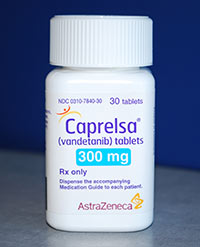|
Information on Vandetanib
Vandetanib (rINN, proposed trade name Zactima), also known as ZD6474, is an antagonist of the vascular endothelial growth factor receptor (VEGFR) and the epidermal growth factor receptor (EGFR). It is a tyrosine kinase inhibitor.
Drug has a third target: inhibits RET-tyrosine kinase activity, an important growth driver in certain types of thyroid cancer.
Current status
Vandetanib is being developed by AstraZeneca. It is a medication currently undergoing clinical trials as a potential targeted treatment for non–small-cell lung cancer. There have been some promising results from a phase III trial with docetaxel. There have also been ambivalent results when used with pemetrexed Another trial with docetaxel was recruiting in July 2009. AstraZeneca withdrew regulatory submissions for Zactima in October 2009 after trials showed no benefit when the drug was administered alongside chemotherapy .
凡德他尼 (vandetanib)是一种合成的苯胺喹唑啉化合物,被称“二代易瑞沙”,为口服的小分子多靶点酪酸激酶抑制剂(TKI),可同时作用于肿瘤细胞EGFR、VEGFR和RET酪氨酸激酶,还可选择性的抑制其他的酪氨酸激酶,以及丝氨酸/苏氨酸激酶。Ⅰ期临床研究显示剂量限制性毒性为腹泻、高血压和皮疹。常见的毒副作用是腹泻、皮疹、恶心、呕吐以及无症状的QT间期延长。其毒副作用与剂量相关,在<300 mg/d时,病人耐受性良好,最大耐受剂量(MTD)为300 mg。Ⅱ期临床研究涉及的病种很多。目前我国正在进行凡德他尼治疗NSCLC的临床试验。
1. 治疗晚期NSCLC(非小细胞肺癌)003号研究比较了凡德他尼 300 mg/d和吉非替尼250 mg/d对一线或二线化疗失败的168例晚期NSCLC病人的疗效,与吉非替尼相比,凡德他尼明显地增加了有效率和延长了疾病无进展生存时间,分别为8%和1%,11.9周和8.1周,(P=0.011)。在临床试验中如果病人病情进展或不能耐受毒性,允许其改变治疗方案。试验结果表明,用吉非替尼代替凡德他尼的病人疾病控制率为14%,而用凡德他尼代替吉非替尼的病人疾病控制率达到32%,预计中位总生存期由凡德他尼→吉非替尼为6.1个月,而由吉非替尼→凡德他尼为7.4个月。0007号研究正在进行中,目的是评价凡德他尼联合紫杉醇(200 mg/m2)+卡铂(AUC=6)一线治疗ⅢB-IV期NSCLC的疗效。初步试验结果显示,凡德他尼可同时联合传统的化疗药物治疗NSCLC,没有明显增加3~4度的不良反应。
2. 治疗晚期乳腺癌46例,既往接受紫杉醇+蒽环类化疗失败的转移性乳癌患者,接受凡德他尼(100 mg或300 mg),44例可评价的患者中未见客观疗效,2组病人各有1例病情稳定(SD)≥24周,作者认为单药凡德他尼治疗复发耐药的乳腺癌疗效有限,但耐受性良好。
3. 治疗晚期多发性骨髓瘤,18例化疗或造血干细胞移植治疗失败的多发性骨髓瘤患者,口服凡德他尼(100 mg)3~29.4周,球蛋白或尿M蛋白未见改善,毒副作用可耐受,常见的毒副作用包括恶心、呕吐、腹泻、皮疹、皮肤瘙痒、感觉障碍等,但未见明确的QT间期改变。
4. 治疗甲状腺癌甲状腺髓样癌发病率低,具有遗传性,无论放射治疗、联合化疗抑或内分泌治疗效果不佳,预后差。0008号研究是一项进行中的、开放的Ⅱ期研究,评估凡德他尼治疗进展期遗传性甲状腺髓样癌的疗效和毒副作用。11例可评价的病人中(接受凡德他尼 300 mg/d,至少3个月),2例患者获得PR,9例患者获SD。另外,病人血浆肿瘤标志物降钙素和癌胚抗原分别较基线值下降了72%和25%。目前人们认为,凡德他尼治疗甲状腺髓样癌主要作用于肿瘤细胞靶点RET酪氨酸激酶,RET可促进肿瘤细胞生长和存活,40%的散发性和100%遗传性甲状腺髓样癌有RET基因的过表达。
适应证和用途
Vandetanib是一种激酶抑制剂适用于治疗不能切除,局部晚期或转移的有症状或进展的髓样甲状腺癌。
因为vandetanib治疗相关风险,在惰性,无症状或缓慢进展疾病患者中使用vandetanib应谨慎小心考虑。
剂量和给药方法
(1)300 mg每天1次
(2)在严重毒性事件或QTc间期延长时可能需要减低剂量
(3)有中度和严重肾受损患者中开始剂量应减低至200 mg。
剂型和规格
100 mg和300 mg片
禁忌证
有长QT综合征患者不要使用vandetanib。
警告和注意事项
(1)曾报道延长的QT间期,尖端扭转型室性心动过速和骤死。在基线,开始vandetanib治疗后2-4周和8-12周,和其后每3个月及剂量调整后,监查心电图和血清钾,钙和TSH水平。当剂量减低适当
(2)曾观察到Stevene-Johnson综合征导致死亡。严重皮肤反应可能促使永远终止vandetanib
(3)曾报道间质性肺疾病征导致死亡。中断vandetanib和研究不能解释呼吸困难,咳嗽,和发热。为间质性肺病应采取适当测量
(4)曾观察到缺血性脑血管事件,出血,心衰,腹泻,甲状腺低下症,高血压,和可逆性后脑白质脑病综合征
(5)当vandetanib给予妊娠妇女可能致死。建议妇女当接受vandetanib和治疗后4个月时避免妊娠
(6)因为QT延长,尖端扭转型室性心动过速和骤死的风险,只能通过严格分配计划被称为vandetanib REMS计划得到vandetanib。只有经认证的处方者和药房能够处方和分配vandetanib。
不良事件
用vandetanib最常见药物不良反应(>20%)曾是腹泻,皮疹,痤疮,恶心,高血压,头痛,疲乏,食欲减退和腹痛。最常见实验室异常(>20 %)是钙减低,ALT升高,和葡萄糖减低
药物相互作用
与已知强CYP 3A4诱导剂同时使用可能减低vandetanib药物水平而应避免(7.1)。Vandetanib与强CYP 3A4抑制剂伊曲康唑[itraconazole]未显示临床意义药物相互作用(7.2)。避免vandetanib与可能延长QT间期药物给药。
On April 6, 2011, the U. S. Food and Drug Administration approved vandetanib tablets (Vandetanib Tablets, AstraZeneca Pharmaceuticals LP), a kinase inhibitor, for the treatment of symptomatic or progressive medullary thyroid cancer in patients with unresectable, locally advanced, or metastatic disease. The use of vandetanib in patients with indolent, asymptomatic or slowly progressing disease should be carefully considered because of the treatment-related risks of vandetanib.
The approval was based on an international, multicenter, randomized, double-blind trial conducted in patients with unresectable locally advanced or metastatic medullary thyroid carcinoma. Patients were randomized (2:1) to receive either vandetanib, 300 mg/day orally, (n=231) or placebo (n=100). The primary objective was demonstration of improvement in progression-free survival (PFS) with vandetanib compared to placebo. Other endpoints included evaluation of overall survival (OS) and objective response rate (ORR). A central, independent blinded review of the imaging data was used in the assessment of PFS and ORR. Upon objective disease progression by the investigator, patients were given the option of receiving open-label vandetanib.
An improvement in PFS was observed for patients randomized to receive vandetanib (HR=0.35; 95% CI: 0.24, 0.53; p<0.0001). Analyses in the subgroups who were either symptomatic or who had disease progression within 6 months prior to enrollment showed similar PFS results: hazard ratios of 0.31 (95% CI: 0.19, 0.53) and 0.41 (95% CI: 0.25, 0.66), respectively. At the primary PFS analysis, 15% of the patients had died; no significant OS difference was noted. The ORR was 44% versus 1% for patients randomized to receive vandetanib or placebo, respectively. All objective responses were partial responses.
QT prolongation, torsades de pointes, and sudden death are included in a boxed warning. Because of vandetanib’s prolonged half-life of 19 days, ECGs and levels of serum potassium, calcium, magnesium and TSH should be obtained at baseline, at 2-4 weeks and 8-12 weeks after starting treatment and subsequently every 3 months. Electrolytes and ECGs may require more frequent monitoring in patients experiencing diarrhea. Only prescribers and pharmacies certified through the Vandetanib Risk Evaluation Mitigation Strategy Program, a restricted distribution program, are able to prescribe and dispense vandetanib.
The most common (≥ 20%) grade 1-4 adverse reactions included diarrhea/colitis, rash, dermatitis acneiform, nausea, hypertension, headache, fatigue, decreased appetite, and abdominal pain. Laboratory abnormalities in > 20% of patients included decreased calcium, increased ALT, and decreased glucose. The most common (≥ 5%) grade 3-4 adverse reactions were diarrhea/colitis, hypertension and hypertensive crisis, QT prolongation, fatigue, and rash. Adverse reactions resulting in death in patients receiving vandetanib (n=5) were respiratory failure, respiratory arrest, aspiration pneumonia, cardiac failure with arrhythmia, and sepsis. In addition, two deaths in patients receiving vandetanib (one sudden death and one death from cardiopulmonary arrest) were noted after data cut-off.
The recommended daily dose of vandetanib is 300 mg orally. The starting dose should be reduced to 200 mg in patients with moderate (creatinine clearance ≥30 to <50 mL/min) and severe (creatinine clearance <30 mL/min) renal impairment.
-------------------------------------------------------------------
原产地英文商品名:
VANDETANIB 300mg/tab 30tabs/bottle
原产地英文药品名:
VANDETANIB
中文参考商品译名:
凡德他尼 300毫克/片 30片/瓶
中文参考药品译名:
凡德他尼
产地国家: 美国
所属类别: 抗癌药物->治疗肺癌药物
处方药:处方药
包装规格: 300毫克/片 30片/瓶
销售单价(美元 US$): 14601美元
销售单价(人民币 RMB): 96368元
计价单位: 瓶

-----------------------------------------------------------------
原产地英文商品名:
VANDETANIB 100mg/tab 30tabs/bottle
原产地英文药品名:
VANDETANIB
中文参考商品译名:
凡德他尼 100毫克/片 30片/瓶
中文参考药品译名:
凡德他尼
产地国家: 美国
所属类别: 抗癌药物->治疗肺癌药物
处方药:处方药
包装规格: 100毫克/片 30片/瓶
销售单价(美元 US$): 7491美元
销售单价(人民币 RMB): 49441元
计价单位: 瓶

| 


